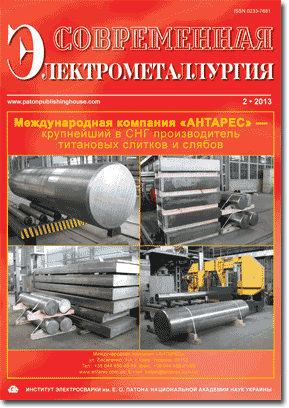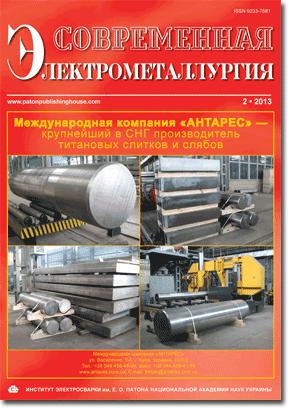| 2013 №02 (08) | 2013 №02 (10) |

Современная электрометаллургия,
СТРУКТУРООБРАЗОВАНИЕ В МНОГОСЛОЙНОЙ РЕАКЦИОННОЙ СИСТЕМЕ Ti/Al
Т. В. Мельниченко
Институт электросварки им. Е. О. Патона НАН Украины
03680, г. Киев, ул. Боженко, 11. E-mail: office@paton.kiev.ua
Реферат
Методами электронной микроскопии, рентгенофазового и дифференциального термического анализов изучены закономерности структурных и фазовых превращений при нагреве многослойной фольги Ti/Al, полученной способом электронно-лучевого осаждения из паровой фазы. Показано, что особенности формирования структуры многослойной фольги Ti/Al при послойном осаждении компонентов из паровой фазы обеспечивают объемную диффузию атомов титана в алюминий и зернограничную диффузию атомов алюминия в титан при термической обработке фольги и влияют на характер формирования ее структурно-фазового состояния. Установлено, что морфологические особенности формирования структуры фольги в условиях ее медленного нагрева определяются периодом чередования слоев и соотношением интенсивностей объемной и зернограничной диффузии. Уменьшение периода чередования слоев обеспечивает интенсивную фрагментацию слоев титана при термообработке фольги Ti/Al. Проведен анализ объемных изменений в фольге при протекании фазовых превращений. Показано, что большинство твердофазных реакций сопровождается уменьшением удельного объема фаз. Изменение объема при протекании твердофазных реакций приводит к формированию пустот в материале фольги и увеличению ее дефектности. Установлено, что формирование структурно-фазового состояния многослойной реакционной фольги при нагреве обеспечивается ее структурной самоорганизацией. Особенности формирования структуры многослойной фольги Ti/Al при нагребе будут влиять на формирование ее физических свойств и возможность практического использования. Библиогр. 21, табл. 2, ил. 7.
Using the methods of electron microscopy, X-ray-phase and differential thermal analysis the regularities of structural and phase transformations were studied in heating of multilayer foil Ti/Al, produced by the method of electron beam deposition from vapor phase. It was shown that peculiarities of formation of structure of multilayer foil Ti/Al at layer-by-layer deposition of components from vapor phase provide the volume diffusion of titanium atoms into aluminium and grain-boundary diffusion of aluminium atoms into titanium at heat treatment of foil and influence the nature of formation of its structural-phase state. It was found that morphological features of formation of foil structure under conditions of its slow heating are defined by a period of layers alternation and ratio of intensities of volume and grain-boundary diffusion. The decrease in period of layers alternation provides intensive fragmentation of titanium layers at heat treatment of foil Ti/Al. Analysis of volume changes in foil during proceeding of phase transformation was carried out. It was shown that most solid-phase reactions are accompanied by decrease in specific volume of phases. The change of volume during proceeding of solid-phase reactions leads to the formation of voids in foil material and increase in its defectiveness. It was found that formation of structural-phase state of multilayer reaction foil during heating is provided by its self-organizing. Peculiarities of formation of structure of multilayer foil Ti/Al during heating will influence the formation of its physical properties and possibility of practical application. Ref. 21, Tables 2, Figs. 7.
Ключевые слова: электронно-лучевое осаждение; многослойная фольга; титан; структура; алюминий; термическая обработка; фазовые превращения; объемный эффект; пористость
Key words: electron beam deposition; multilayer foil; titanium; structure; aluminium; heat treatment; phase transformations; volume effect; porosity
Поступила 01.04.2013
Опубликовано 23.05.2013
1. Lewis C., Josell D., Weihs T.P. Stability in thin film multilayers and microlaminates: the role of free energy, structure, and orientation at interfaces and grain boundaries // Scripta Materialia. – 2003. – V. 48. – P. 1079—1085.
2. Ma E., Thompson C.V., Clevenger L.A. Self-propagating explosive reactions in Al/Ni thin films // Appl. Phys. Lett. – 1990. – V. 57. – P. 1262—1264.
3. Рогачев А.С. Волны экзотермических реакций в многослойных нанопленках // Успехи химии. – 2008. – № 77. – С. 22—38.
4. Crone J.C., Knap J., Chung P.W. Role of microstructure in initiation of Ni—Al reactive multilayers // Appl. Phys. Lett. – 2011. – V. 98. – P. 1—3.
5. Мовчан Б.А., Демчишин А.В. Исследование структуры и свойств толстых вакуумных конденсатов никеля, титана, вольфрама, окиси алюминия и двуокиси циркония // Физика металлов и металловедение. – 1969. – 28, № 4. – С. 653—660.
6. Gavens A.J., Heerden D.V., Mann A.B. Effect of intermixing on self-propagating exothermic reactions in Al/Ni nanolaminate foils // J. Appl. Phys. – 2000. – V. 87. – P. 1255—1263.
7. Adams D.P., Hodges V.C., Bai M.M. Exothermic reactions in Co/Al nanolaminates // Ibib. – 2008. – V. 104. – P. 043502(1-7).
8. Adams D.P., Rodniguez M.A., McDonald J.P. Reactive Ni/Ti nanolaminates // Ibid. – 2009. – V. 106. – P. 093505(1-8).
9. Duarte L.I., Viana F., Ramos A.S. Diffusion bonding of gamma-TiAl using modified Ti/Al nanolayers // J. of Alloys and Compounds. – 2012. – V. 536. – P. 424—427.
10. Ищенко А.Я, Фальченко Ю.В., Устинов А.И. Диффузионная сварка композитов АМг5 + 27 % Al2O3 с применением нанослойной фольги Ni/Al // Автомат. сварка. – 2007. – № 7. – C. 5—9.
11. Ustinov A.I., Falchenko Yu.V., Ishchenko A.Ya. Diffusion welding of ?-TiAl based alloys through nano-layered foil of Ti/Al system // Intermetallics. – 2008. – 16, № 8. – P. 1043—1045.
12. Cao J., Feng J.C., Li Z.R. Microstructure and fracture properties of reaction-assisted diffusion bonding of TiAl intermetallic with Al/Ni multilayer foils // J. of Alloys and Compounds. – 2008. – V. 466. – P. 363—367.
13. Wang J., Besnoin E., Duckam A. Room-temperature soldering with nanostructured foils // Appl. Phys. Lett. – 2003. – 83, № 19. – P. 3987—3989.
14. Swiston Jr.A.J., Hufnagel T.C., Weihs T.P. Joining bulk metallic glass using reactive multilayer foils // Scripta Mater. – 2003. – 48, № 12. – 1575—1580.
15. Duckam A., Spey S.J., Wang J. Reactive nanostructured foil used as a heat source for joining titanium // J. Appl. Phys. – 2004. – V. 6. – P. 2336(1-7).
16. Wang J.J., Besnoin E., Duckham A. Joining of stainlesssteel specimens with nanostructured Al/Ni foils // Ibid. – 2004. – 95, №1. – P. 248—256.
17. Tong M.S., Sturgess D., Tu K.N. Solder joints fabricated by explosively reacting nanolayers // Appl. Phys. Lett. – 2008. – 92, № 14. – P. 144101(1-3).
18. Paton B.E., Movchan B.A. Composite materials deposited from the vapour phase in vacuum // Soviet technology reviews. Section C, Welding and surfacing reviews. – 1991. – V. 2. – P. 43—64.
19. Шишкин А.Е., Шишкин Е.А., Устинов А.И. Термический анализ микрослойных присадок на основе интерметаллидообразующих элементов // Автомат. cварка. – 2007. – № 12. – С. 30—34.
20. Murr L.E. Interfacial phenomena in materials and alloys. – Massachusetts: Addison-Wesley; 1975. – 376 p.
21. Устинов А.И., Олиховская Л.А., Мельниченко Т.В. Твердофазные реакции при нагреве многослойных фольг Al/Ti, полученных способом электронно-лучевого осаждения // Современ. электрометаллургия. – 2008. – № 2. – С. 19—26.
Вартість передплати/замовлення на журнали або окремі статті
| журнал/валюта | річний комплект друкований |
1 прим. друкований |
1 прим. електронний |
одна стаття (pdf) |
| AS/UAH | 1800 грн. | 300 грн. | 300 грн. | 150 грн. |
| AS/USD | 192 $ | 32 $ | 26 $ | 13 $ |
| AS/EUR | 180 € | 30 € | 25 € | 12 € |
| TPWJ/UAH | 7200 грн. | 600 грн. | 600 грн. | 280 грн. |
| TPWJ/USD | 384 $ | 32 $ | 26 $ | 13 $ |
| TPWJ/EUR | 348 € | 29 € | 24 € | 12 € |
| SEM/UAH | 1200 грн. | 300 грн. | 300 грн. | 150 грн. |
| SEM/USD | 128 $ | 32 $ | 26 $ | 13 $ |
| SEM/EUR | 120 € | 30 € | 25 € | 12 € |
| TDNK/UAH | 1200 грн. | 300 грн. | 300 грн. | 150 грн. |
| TDNK/USD | 128 $ | 32 $ | 26 $ | 13 $ |
| TDNK/EUR | 120 € | 30 € | 25 € | 12 € |
AS = «Автоматичне зварювання» - 6 накладів на рік;
TPWJ = «PATON WELDING JOURNAL» - 12 накладів на рік;
SEM = «Сучасна електрометалургія» - 4 наклада на рік;
TDNK = «Технічна діагностика та неруйнівний контроль» - 4 наклада на рік.





